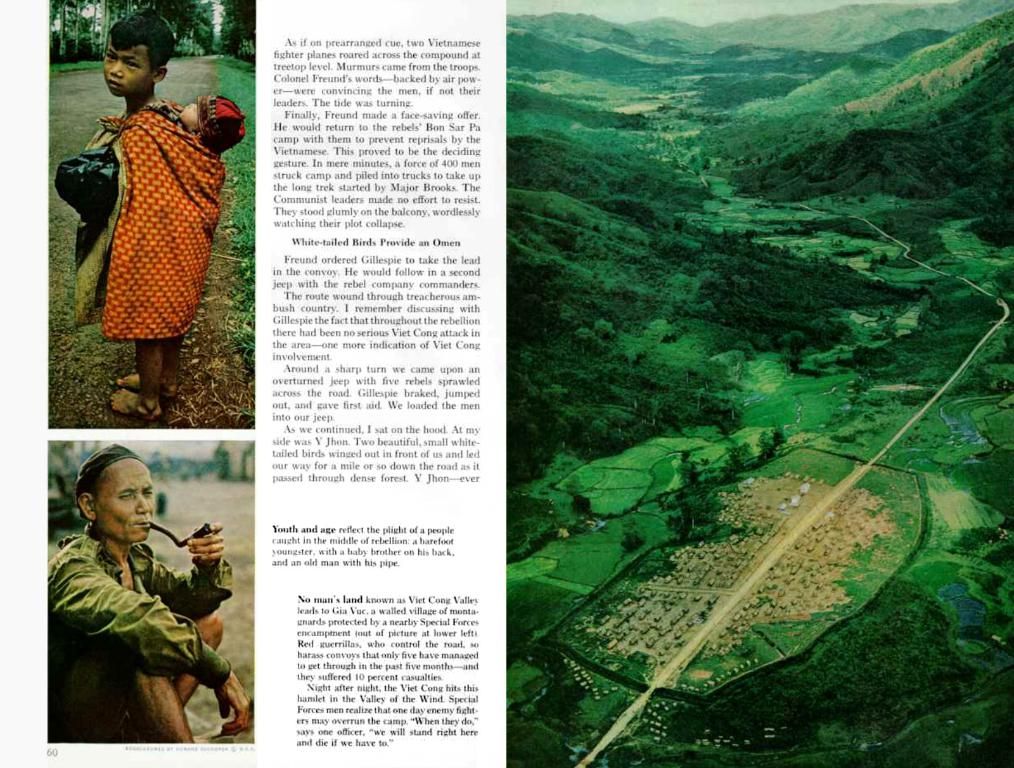Unrecognized Nation Struggling for Existence: Exploring the Nagorno-Karabakh Republic
In the year 2024, the Nagorno-Karabakh Republic (NKR) - the heart of the long-standing Armenian-Azerbaijani conflict - officially ceased to exist, following the mandate of its last leader, Samvel Shahramanyan, to dissolve it on September 28, 2023. This decision was a condition of the ceasefire that ended Azerbaijan's military operation against the NKR on September 19-20.
Since its emergence, the NKR had been the primary point of contention between Armenians and Azerbaijanis, representing a significant theme in their ongoing "meta-conflict" over the true nature of their struggle. Azerbaijan has consistently sought to merge its conflict with the Armenian population in Karabakh into a broader, irredentist framework with Armenia, while Armenia has strived to minimize its role in the conflict by depicting the NKR as an integral part of its interests.
Scholars often described the NKR as a "de facto state" - a secessionist entity with a permanent population and fixed borders that nonetheless remains unrecognized by other states. These entities are the byproduct of the international system that favors the sanctity of sovereign, equal states, creating a paradoxical existence for such states outside its boundaries.
The NKR was proclaimed independent on September 2, 1991, by the regional soviets of the Nagorno-Karabakh Autonomous Oblast (NKAO) and Shahumyan region, in response to Azerbaijan's declaration of independence two days prior. The NKAO's aim was unification with Armenia, known as miatsum, a long-standing goal dating back to the First World War. However, this territorial non-contiguity made the NKR particularly vulnerable to geopolitical and military considerations, transforming it into an exceptional case among de facto states.
Armenian forces conquered the seven surrounding regions of Lachin, Kelbajar, Qubatly, Zangilan, Jebrayil, Agdam, and Fizuli between May 1992 and May 1994. This carving out of territories surrounding the NKAO was a "resolved" issue in the conflict, as territorial control is synonymous with ethnic cleansing in the Armenian-Azerbaijani conflict. Both Armenians and Azerbaijanis found new homes in the NKR, resulting in a dual constitution of the region.
The ambiguity of unification resulted in tactical sovereignty for the NKR, combined with strategic integration with Armenia at various levels. The NKR had the symbols and bureaucratic architecture of a government, including an executive, legislative, and judicial branch. Nonetheless, the NKR's dependence on Armenia was evident in financial subsidies, military transfers, and deep interconnections between their ostensibly separate armies.
The NKR's democratization attempt, characterized by multiple candidates, free campaigns, and relatively free elections, secured its "partly free" status in the Freedom House's "Freedom in the World Index." However, opposition representation was limited, civil society remained marginalized, and the 2017 constitution introduced a fully presidential system, enabling Bako Sahakyan to extend his tenure by over a decade.
The security situation along the Line of Contact with Azerbaijan deteriorated from 2014, with frequent skirmishes and escalations. The "four-day war" in April 2016 marked a significant advance for Azerbaijani forces along the Line of Contact. Russia's support for de facto states like Donetsk and Lugansk People's Republics in eastern Ukraine cast doubts over the NKR's legitimacy, as it was perceived as a puppet regime without previous popular support.
The Second Karabakh War in 2020 resulted in the partition of the NKR, with the remaining parts being placed under Russian control. This new status quo presents a convergence with other post-Soviet de facto states, requiring a Russian approach to freeze the conflict and postpone status decisions to the distant future. The war eliminated Armenia's capacity to act as a patron state, leaving the NKR's fate uncertain in the face of geopolitical shifts and tensions.
- The dissolution of the Nagorno-Karabakh Republic (NKR) in 2023 opened up discussions in various fields such as politics, history, and general news, as its cease-fire marked an end to the long-standing Armenian-Azerbaijani conflict.
- Sports and education-and-self-development sectors might also find interest in this event, as understanding the complexities of the NKR's history could inspire deeper discussions on persistence, conflict resolution, and self-determination.
- The dissolution of the NKR raises questions about war-and-conflicts, particularly its ongoing impact on relationships between Armenians and Azerbaijanis, and the potential for resolving similar meta-conflicts in the future.
- Journalists and scholars monitoring international events and news will likely cover this transition, considering the implications for de facto states and the paradoxical existence they hold in the international system.
- The changing dynamics of the NKR, including its annexation by Azerbaijan following the Second Karabakh War in 2020 and its subsequent placement under Russian control, has reshaped the environment for years to come, with potential consequences for regional stability and global politics.




